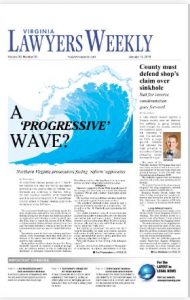
Federal False Claims Act Settlement of $20.7 million against the Virginia Neurological Birth Injury Fund
I am pleased to announce some old/new news — late last year a federal False Claims Act case in which I was involved settled for $20.7 million against the Virginia Neurological Birth Injury Fund.
I was co-counsel on the case with Scott Austin of GentryLocke. The Richmond-Times Dispatch had an article about the settlement recently; this was actually the second article in the RTD about the case. The first came out in April of 2017 when the Fund itself confirmed the existence of a DoJ investigation into allegations that the Fund had violated the federal False Claims Act…
History and Purpose of the Virginia Neurological Birth Injury Fund
The Virginia Birth-Related Neurological Injury Compensation Program was created in 1987 to address a rise in medical malpractice insurance rates for obstetricians. Such rates were — and still are — the highest of any health care provider. There is a simple reason for this. The monetary damages that result from serious birth-related injuries to children often require life-long care for the child. In addition to the obvious expenses the child’s family incurs, the nature of neurological injuries often limits the ability of the child to work and earn a living.
The Program’s enabling legislation, codified at Va. Code. Ann. § 38.2-5000 et seq. removed these medical malpractice claims from the tort system. The law provides an alternative means for compensating those affected by birth-related neurological injuries. The Birth-Injury Program does not receive state funds. Funding is instead provided through four sources: Participating physician and hospital fees; assessments of liability insurance carriers operating in Virginia; and assessments of non-participating physicians practicing in Virginia.
Monetary awards under the Program are exclusive. If an injury is covered by the Program, the child is not entitled to compensation from a malpractice lawsuit. Instead, the child is eligible for a lifetime of benefits from the Birth-Injury Program. Admission to the Program is determined by the Virginia Worker’s Compensation Commission.
So far, so good. So what went wrong at this innovative program that resulted in false claims to the United States? That’s an easy one.
The Birth-Injury Fund Essentially Operated to the benefit of the Insurance and Healthcare Industries
The Fund is overseen by a nine-member volunteer board of directors. As you might guess, the board came to be dominated by the insurance and health care industries. Lest anyone dismiss this statement as hyperbole, the General Assembly’s Joint Legislative and Audit Review Committee (“JLARC”) issued a scathing 2002 review of the Program. JLARC plainly stated that the primary interest of the Board has been to keep the premiums and other payments from health care industry participants as low as possible, without regard for the financial stability of the Fund.
The Fund Tried to Keep Fees and Costs as Low as Possible and in the process violated the federal False Claims Act
Between 1995 and 2000, the Board introduced a sliding scale assessment plan. Under the scale, Program participants actually paid reduced dues based on the number of years that they had been involved in the Program. This is the exact opposite of how most professional malpractice policies work. Generally speaking, Professional liability insurance premiums increase over time because the longer the policy has been in effect, the higher the possibility that a claim will be made.
Similarly, insurance premiums also typically increase for high-volume providers. This is also easy to understand. Statistically speaking, a hospital that has 11,000 births per year year will have a greater chance of a serious birth injury. Despite this mathematical certainty, hospitals were assessed a fee of $55 per live birth up to a maximum of $200,000.
By reducing the fees of these participating insurance companies, hospitals, and physicians, the Program reduced its own income by 65 percent. In 1998, the Program received only $1,025,792 in annual dues from the participating liability insurers, participating hospitals, and non-participating physicians combined to provide for nearly 40 members of the Program. Bearing in mind that neurological birth injuries are the most costly injuries of any medical malpractice case, the Program collected dues of only $26,300 per Program member in 1998.
Even more incredibly, in 1998 the Fund declared a complete moratorium on fees altogether.
“Dual-Eligibles” and the Birth Injury Fund
So what steps did the Fund take to limit its expenditures? Part of the answer is that it passed expenses on for “dual eligible” patients. To be dual eligible simply means that a person has overlapping coverage by both a government payer and a private plan. In addition to paying for the care of a “dual eligible” beneficiary, private insurers are required to reimburse claims erroneously paid by Medicaid.
And that is because Medicaid is always the “payer of last resort.”
The current Medicaid statute ( found at 42 U.S.C. §1396a(a)(25)(A)-(B)) requires States who receive federal funds for Medicaid to “take all reasonable measures to ascertain the legal liability of third parties … to pay for care and services available under the plan,” and requires States to “seek reimbursement from the third party,” and to “prohibit any health insurer (including … [a] party that is, by statute, contract, or agreement, legally responsible for payment of a claim…) … from taking into account that the individual is eligible for or is provided medical assistance under a plan under this title.”
The Fund qualified as a “party that is, by statute, contract, or agreement … legally responsible for the payment of a claim.” Therefore, Medicaid properly covers only those expenses not paid for the Fund. The Fund tried — and for years, succedded — in making itself the “payer of last resort.” In the process, the Fund caused false claims to be submitted to government healthcare programs.
And that was the basis of the federal False Claims Act case filed by my firm and Gentry Locke in 2015.
The other part of the answer is that the Fund often took an combative approach to Fund participants. And, what’s worse, the more expensive the benefit sought by a given participant, the more combative the Fund became.
But not any more.
The Settlement Agreement that resolved the federal False Claims Act cases is attached, as is the order of dismissal entered on September 22, 2018. In addition to the payment, the Fund also agreed to make certain disclosures which you can also read on thier website.




